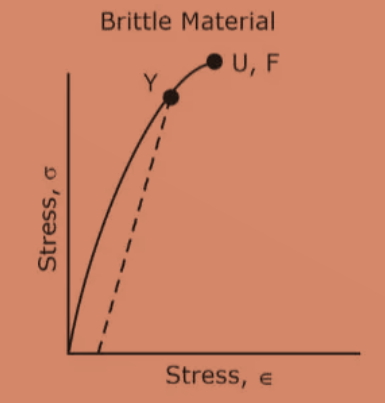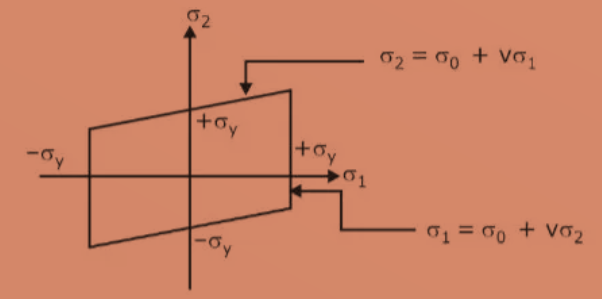Brittle Material – Definition, Properties, Examples
By BYJU'S Exam Prep
Updated on: September 25th, 2023

Brittle material is a material that undergoes very less deformation during its failure. In the world of designing structures or equipment, materials and resources are the main basic needs to complete the design. Material can be classified into Ductile and Brittle materials based on their property.
Brittle material failure occurs when stress value exceeds elastic limit stress without attaining sufficient deformation. It has a very small amount of plastic zone and generally fails under tensile stress, which occurs at 90o to the axis. Let us discuss the stress-strain curve for brittle materials, along with certain important properties and examples.
Download Formulas for GATE Civil Engineering – Environmental Engineering
Table of content
-
1.
What is Brittle Material?
-
2.
Stress Strain Curve for Brittle Material
-
3.
What is the Theory used for Designing Brittle Materials?
-
4.
Properties of Brittle Materials
-
5.
Comparison Between Ductile and Brittle Materials
-
6.
Difference Between Stress-Strain Curve of Ductile and Brittle Materials
-
7.
-
8.
Brittle Material Examples
What is Brittle Material?
When under stress, brittle material cracks while absorbing little to no energy. No plastic distortion causes the material to fracture. Usually, when brittle material breaks, there is a loud audible snap sound. A substance with limited ductility is also referred to as being brittle.
Further, we have discussed the theory used for designing, examples, properties, stress-strain curve, and the difference between ductile and brittle materials.
Download Formulas for GATE Civil Engineering – Structural Analysis
Stress Strain Curve for Brittle Material
The stress-Strain curve is the curve that shows the variation of stress induced in a material with the strain applied over it. Below the curve is the stress-strain curve for brittle material, which shows the variation of stress to strain.

Download Formulas for GATE Civil Engineering – Geotechnical Engineering
What is the Theory used for Designing Brittle Materials?
The theories used for designing the Brittle material are the maximum principal stress theory and maximum principal strain theory. These theories are based on maximum principal stress and maximum principal strain. These theories are described below-
Maximum Principal Stress Theory
Maximum principal stress theory is also known as Rankine theory. According to this theory, material failure will occur when the principal stress caused by any combination of loads is equal to the principal stress induced in the case of uniaxial loading.
For designing using brittle materials, failure is considered when the stress value exceeds the yield stress. ie.
σ1,2≤σy, For no failure of the material
σ1,2≤σy/FOS , For designing

Maximum Principal stress theory gives the best result for designing brittle materials.
Maximum Principal Strain Theory
Maximum principal strain theory is also known as St. venant theory. According to this theory, material failure will occur when the principal strain caused by any combination of loading is equal to the principal strain induced in the case of uniaxial loading.
The principal strain (Ε1,2) for uniaxial loading is σy/E.
The principal strain (E1,2) for the combination of loading is σ1/E-νσ2/E-νσ3/E
So, For no failure of the material,σ1/E-νσ2/E-νσ3/E≤σy/E
or σ1-νσ2-νσ3≤σy
And for designing, σ1-νσ2-νσ3≤σy/FOS
Where ν is the Poisson ratio of the material.

Maximum principal strain theory can be used for both ductile and brittle materials.
Properties of Brittle Materials
Properties of brittle materials are the inherent characteristics of materials that describe the different design parameters of materials. Here are some properties of brittle material.
- Brittle materials fail in tension.
- There is no or very less plastic strain in a brittle material.
- Brittle materials have high compressive strength and very low tensile strength.
- Brittle materials have a very low capacity to resist impact and vibratory load.
Comparison Between Ductile and Brittle Materials
Ductile material shows significant deformation after its elastic limit, and brittle material shows insignificant deformation after its elastic limit. Here some comparisons between ductile and brittle materials are illustrated below.
|
Ductile Material |
Brittle Material |
|
Ductile materials have significant deformation before their failure |
Brittle material does not possess significant deformation before its failure. |
|
Ductile material is weak in shear. |
Brittle material is weak in tension. |
|
Ductile materials have a significant amount of plastic zone. |
Brittle materials have a very less amount of plastic zone. |
|
Ductile material can be converted into wires. |
Brittle materials are hard in nature; hence they cant be formed into wires. |
Difference Between Stress-Strain Curve of Ductile and Brittle Materials
Stress-strain curves for ductile material have more plastic regions, but there is no or very small plastic region for brittle material. Here are the differences between the ductile and brittle materials’ stress-strain curves.
Brittle Material Examples
In civil engineering construction, many materials are used in which concrete is a
significant constituent. Here, some examples of brittle materials are given, which help to understand the properties of brittle materials.
Concrete: Concrete is a brittle material that is strong in compression and weak in tension.
Concrete is used as a major constituent of civil engineering construction works. Failure of plain concrete occurs without giving sufficient deformation.
Rubber: Rubber is a major confusion that rubber is a malleable material because it gives sufficient deformation without failure, but rubber has very less deformation after it’s yielding hence it is a brittle material.
Some brittle material examples in metals are High carbon content steel, Cast iron, and Pig iron.



